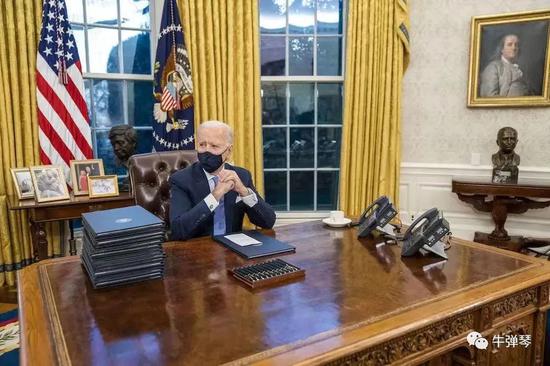After U.S. President Biden officially took office on the 20th, he has launched a number of administrative measures, including the Paris Agreement on the return of the United States to address climate change, and his Democratic-controlled Senate is also actively promoting the confirmation process required by relevant cabinet members before taking office.
The United States that Biden took over is deeply in multiple crises: more than 400,000 coronavirus deaths, unprecedented political tearing, weak economic employment, and high debt risk.
Against this background, what exactly the president’s ruling team is particularly important.
Some analysts pointed out that the use of “Old Washington” in order to quickly function of the government, diversified personnel backgrounds to achieve political unity, and the return of the campaign “meritorious officials” have become the main characteristics of Biden’s cabinet nomination.
Who was hit?
In addition to the Vice President, the U.S. Cabinet also includes 15 executive heads, including the Secretary of State, the Secretary of the Treasury, the Secretary of Defense, and the Attorney General.
In addition, important positions such as the White House Chief of Staff, the Assistant to the President for National Security Affairs, the Director of National Intelligence, and the U.S. Trade Representative have cabinet levels.
Biden has completed nominations or direct appointments to all cabinet and cabinet-level officials before taking office, and the Senate is now beginning to consider and vote on nominees who need to be approved by him.
On the 20th, the Senate approved Evril Haynes as the director of national intelligence, the first cabinet-level official of the Biden administration confirmed by the Senate.
Biden’s important cabinet nominations include: former Undersecretary of State Anthony Blinkin, former Federal Reserve Chairman Janet Yellen as Secretary of the Treasury, retired four-star General Lloyd Austin as Secretary of Defense, and Chief Justice Merrick Garland of the Court of Appeals for the Federal Circuit of the District of Columbia as Attorney General.
These four positions, traditionally known as the “Big Four” of the Cabinet, have higher importance and exposure.
Among several cabinet-level positions of concern, Biden appointed Ron Klein, who served as his campaign adviser, as the White House Chief of Staff; appointed Jack Sullivan, Vice President National Security Adviser at the Obama administration, as the President’s National Security Assistant; and nominated the House Ways and Means Committee of Representatives.
Dai Qi, the chief trade adviser of the Council, served as the U.S. Trade Representative and so on.
In addition, Biden has done some “addition and subtraction” to cabinet-level positions.
For example, he created the post of presidential special envoy on climate and appointed former Secretary of State John Kerry to re-elevate the permanent representative of the United States to the cabinet level, but the director of the Central Intelligence Agency no longer has the cabinet level.
It’s quite useful.
Some analysts pointed out that many of Biden’s cabinet are senior officials under the former President Obama administration, and some have even been the first or second leaders of the federal government.
The USA Today editorial said that many of the candidates for Biden’s cabinet are Washington’s “old rivers and lakes” with rich policy experience and familiarity with the operation of the federal government.
The United States now faces multiple difficulties, and federal government agencies need these “squaintances” to take over to bring more stability.
At the same time, it is worth noting that Biden’s cabinet candidates also pay attention to balancing gender, race and other factors, and do not forget to bring up their descendants to reward the campaign for “meritorious officials”.
If all candidates are successfully approved by the Senate, a series of “firsts” will be created: the first Native cabinet minister in U.S. history, the first female finance minister, the first African-American defense minister, the first Latino secretary of health and human services, the first immigrant-born Secretary of homeland security, the first Asian-American trade representative, etc.
It is worth mentioning that Kamala Harris has made history and became the first female vice president of the United States.
Biden also nominated Pete Buttigieg, former mayor and former Democratic presidential candidate for South Bend, Indiana, as Secretary of Transportation.
According to the U.S. media, 39-year-old Buttigieg is one of the emerging stars in Democratic politics. It may be a matter of time before he can run for president again. Biden intends to help him “brush his resume”.
In addition, almost all the “meritorious officials” of the Biden campaign have been entrusted with important positions, which is also the usual practice of selecting and employing people for new presidents.
Facing obstacles
At present, Democrats and Republicans each hold 50 seats in the Senate, and the vice president holds a decisive vote as the president of the Senate.
This means that, not surprisingly, Biden’s cabinet nomination will be passed smoothly in the Senate.
However, some analysts pointed out that what makes the situation slightly complicated is that the current Senate not only needs to start hearing the presidential impeachment against former President Trump after leaving office, but also to consider a new round of coronavirus economic rescue plans.
These time-consuming agendas may affect the Senate’s consideration and approval of cabinet nominations. Progress.
In an article in the U.S. Politico, considering the partisan strife caused by the impeachment, it is not easy for Biden’s cabinet to get approved quickly.
Biden expressed concern and called on the Senate to “work in parallel”, half a day for the hearing of impeachment, the other half a day for considering and approving his cabinet candidates and promoting a new economic rescue plan for the coronavirus epidemic.
At present, Biden has appointed a series of acting officials to temporarily take charge of important federal government institutions until the Senate approves the official candidate to ensure that the government department can function properly during the transition period.



